
How to remove construction foam
Construction foam insulates, seals and bonds. And this is exactly what it should do! Unfortunately, it does not always land where it is supposed to. If, despite taking all precautions, there are splashes - how do you get rid of them? PU foam is stubborn and very difficult to remove.
Here you can find practical tips on how to remove foam residues chemically or mechanically, and what tools you need. There are also four practical examples on how to proceed and what you can do to avoid splashes.
Speed is the key to removing fresh construction foam!
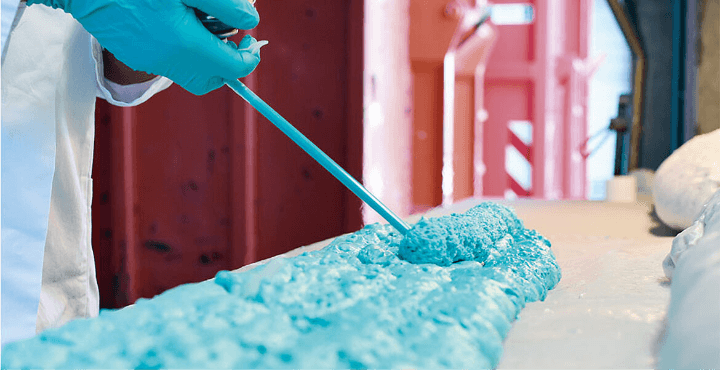
The most important piece of advice: the quicker the better! Construction foam is easiest to remove when it is fresh and has not yet hardened. If possible, stop working immediately and wipe the fresh PU foam off carefully with a cloth. Ideally, you should soak the cloth in a conventional vegetable oil. This allows you to remove the foam residues even more easily.
Ensure that you do not smear the foam. We recommend using several cloths to remove larger quantities of foam. You can mop up the fresh foam more easily without smearing any unaffected areas.
Extra tip
Some professionals swear by baby wipes to wipe away fresh foam. These oily cleaning wipes allow the foam to be removed very gently.
How to remove dried construction foam?
Strictly speaking, PU foam does not dry, it hardens. Once the construction foam has hardened, it will be more difficult to remove. You can try to remove it mechanically or with chemical agents. We will show you what helps.
Removing construction foam mechanically - the best tricks and tools
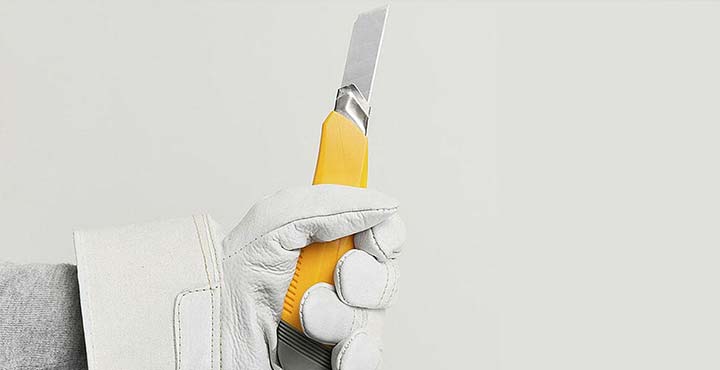
Simply cut off large pieces of PU foam residues
Cut off as much of the residual material as possible first. The less construction foam on the surface, the easier it is to remove. Please be careful when cutting and ensure you do not slip and damage the surface or harm yourself.
The best tools for this work are
- razors,
- carpet knives,
- cutters,
- or any other sharp blades suitable fine work or for using carefully on surfaces.
Mechanical removal of fine PU foam residues.
The more critical work steps are conducted once the larger residues have been removed. Primarily, it depends on the surface.
- Soft and sensitive surfaces can be treated carefully with a fine steel wool or fine sandpaper. You could also try out one of the more gentle wet methods. To do this, moisten a household sponge with water and a detergent, and then try to use the rough side of the sponge to rub off the foam residues carefully.
- Moderately hard surfaces for instance, plastic windows or window sills, can be sanded with a fine wire brush.
- Very hard surfaces can also be treated with a Ceran hob scraper.
CAUTION! You should always try one the described methods first on a less visible part, so there are no unwelcome surprises or scratches. This is the only way for you to decide what bothers you more: possible scratches or PU foam residues?
Chemical removal of construction foam
An alternative to the mechanical methods for the removal of hardened residues is to treat the stains with a special PU foam remover that removes them chemically. They are available from DIY stores and special retailers. PU foam removers contain solvents and other synthetic substances that can release the construction foam.
However, before you use chemical agents, you should also remove larger residues with a sharp blade first, as described above. Only then should you use a PU remover.
Chemically remove fine PU foam residues with a PU foam remover
All PU construction foam removal agents function and are applied in a very similar manner. However, the exposure times of the different agents may vary. Please read the manufacturer's instructions first. Otherwise, the following three steps generally apply:
- Cut off as much of the residual PU foam as possible before applying the removal agent.
- Apply the removal agent as stated on the packaging.
- Allow the agent to work for approx. 30 minutes (read the manufacturer's instructions for the respective product)
- Remove the softened residues with a wooden spatula. Do not use any more water here.
- Then clean the area again.
- Repeat the process if necessary.
What else should you bear in mind when using PU foam removers?
When selecting the removal agent, ensure that it is suitable for the respective surface. To do this, read the instructions on the packaging or ask your dealer.
In general, PU foam removers are compatible with
- tiles,
- stone,
- glass,
- wood
- aluminium,
- steel,
- laminate,
- Resopal
PVC is only partially suitable. Special care needs to be taken with anodised materials and varnished surfaces.
Important: Test the PU remover on a concealed place first
In general, PU removal agents can cause unwanted discolouration of the surface. Therefore, you should always test it first on a concealed place first to check the compatibility of the construction foam removal agent and the surface. Only when this test has been passed should you try it out on the actual place.
Important! Protect skin and eyes
PU foam removal agents work on the basis of a chemical reaction. Like all chemical construction products, you should always avoid contact with skin or eyes and wear protective clothing. For example, with gloves, long sleeves and trouser legs, and goggles. Also, always ensure that the work area is well ventilated.
Are there alternatives to PU foam remover?
As long as the foam has not hardened, you can try to remove the foam residues with an acetone-based nail varnish remover. However, acetone will not work on hardened construction foam. Here, too, you should always test it first on a concealed place to check if the fluid is compatible with the surface.
Removing construction foam - four practical examples
You now know the most effective methods. Here are some practical examples you can also try; however, we recommend always trying the gentler methods first before you resort to full force.
1. Removing construction foam from plastic window frames
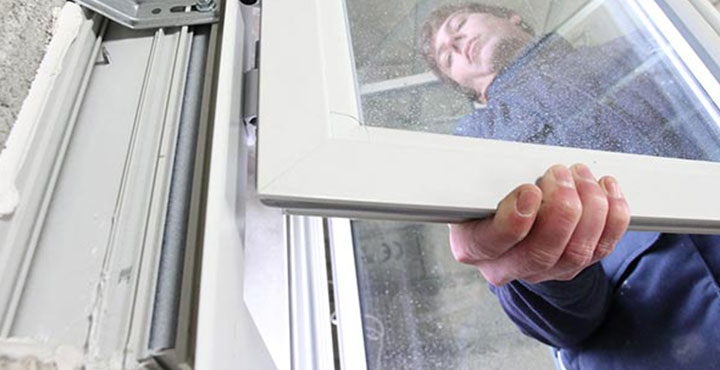
- Cut off the larger residual material carefully with a knife or a razor.
- Then moisten a household sponge with water and a detergent, and use the rough side to try to rub off the construction foam carefully.
- Alternatively, you can try a dry method by rubbing the foam residues with a fine wire brush, steel wool or fine sandpaper.
- If that doesn’t help, you can try chemical methods with PU foam removers in which the dried PU foam is released with the remover and then scraped off with a spatula.
Whatever method you choose, you should always try it out on a less visible part first, especially if you are going to use a chemical agent. Please ensure that the frame is compatible with the cleaning agent. Certain coats of paint, imprints of plastic windows and window synthetics can be corroded by the cleaning agent.
2. Removing construction foam from wooden window frames

The procedure for wooden windows is the same as for plastic windows. But much greater care is required. It may not be possible to completely clean open-pore wooden window frames because the foam penetrates the wood pores deeply and the discolouration cannot be completely removed.
If the type of wooden window allows it, you can also sand down the respective places and then repaint the frame.
In the case of sensitive window frames, you can protect the frame with masking tape. After assembly, simply wait until the window foam has hardened. Then the PU foam can be removed easily with the tape and you have a clean window frame.
3. How to remove construction foam from skin and hands
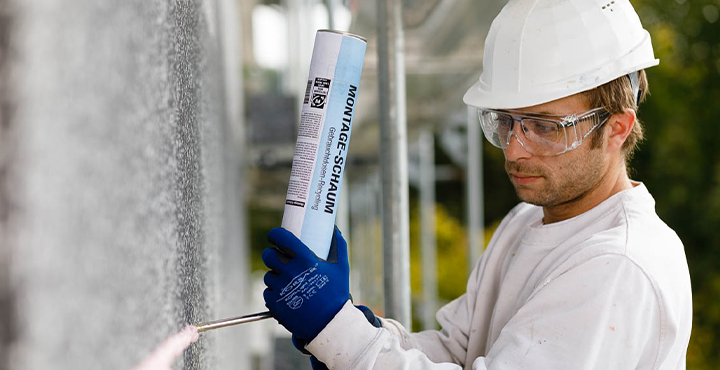
It is generally not a good idea to use a chemical cleaner on skin. The only thing to do here is be patient. There are four methods you can try:
- Fresh foam is best removed from the skin with a cloth soaked in normal cooking oil.
- Rub off the foam with plenty of water, detergent and patience.
- You can also try a hand-washing paste or abrasive milk.
- You can use baby wet wipes. This is a particularly good idea, if the foam has not yet hardened.
Afterwards you should cream your hands well so that the skin can regenerate.
To avoid subsequent removal, we advise protecting your own skin from splashes of assembly foam by wearing gloves and long sleeves. You can protect your eyes by wearing goggles.
4. Clean clothing soiled with construction foam
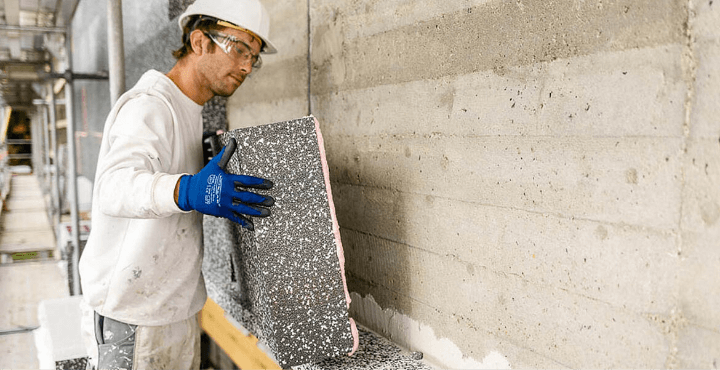
To be honest, it is almost impossible to remove construction foam from textiles. Simply putting the garment into the washing machine will not help because the foam bonds too well with the textile structure and penetrates the fibres.
You can try to remove foam from denim or canvas by scratching at it with your fingernails or a spatula. It is probably not possible to prevent discolouration of the fabric.
As long as the foam is still fresh, you could try nail varnish remover. The solvent may also damage the fibres of the fabric.
Instead of being annoyed later, we recommend wearing workwear or old clothes on which stains don’t matter.
Protective measures: How to remove PU foam splashes
Whatever removal method you choose, the best method is of course to avoid splashes on sensitive surfaces from the outset. The ultimate tip is to cover neighbouring areas before commencing work.
You can take some precautions in advance to allow the removal of construction foam from unwanted places. Simply mask these areas with plastic film or tape. Then simply pull off the film or tape to remove the hardened construction foam.
This also applies to other materials like glass or other very smooth construction materials and parts. If the surface is prepared correctly, this will even work years later.
You must always protect yourself by covering all your skin, i.e. wear long trousers, long sleeves and also gloves. Also, wear goggles to protect your eyes against PU foam splashes.

![[Translate to Englisch:] Zargenschaum [Translate to Englisch:] Zargenschaum](/fileadmin/PU-Schaum-Center/PU-Schaumarten/img_PU-Schaumarten_Zargenschaum_Innentueren.png)
![[Translate to Englisch:] Fensterschaum [Translate to Englisch:] Fensterschaum](/fileadmin/PU-Schaum-Center/PU-Schaumarten/img_PU-Schaumarten_Fensterschaum.png)
![[Translate to Englisch:] PU-Schaum richtig verarbeiten [Translate to Englisch:] PU-Schaum richtig verarbeiten](/fileadmin/PU-Schaum-Center/PU-Schaum_in_der_Praxis/img_PU-Schaum_richtig_verarbeiten.jpg)

